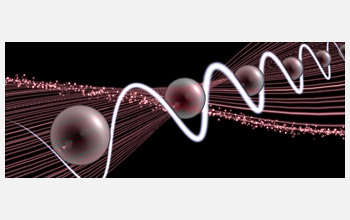Multimedia Gallery
Trapping Rydberg Atoms
An artist's depiction of Rydberg atoms trapped in a one-dimensional optical lattice--a crate made of interfering laser beams. Researchers from the University of Michigan department of physics, who developed the trap, believe this achievement could help enable fast quantum computers.
Rydberg atoms are highly excited, nearly-ionized giants that can be thousands of times larger than their ground-state counterparts. As a result of their size, interactions between Rydberg atoms can be roughly a million times stronger than between regular atoms, which is why researchers believe they could serve as faster quantum circuits. Quantum computers could solve problems too complicated for conventional computers. The trap was developed by researchers from the University of Michigan department of physics with funding from grants from the National Science Foundation (PHY 08-55871 and PHY 01-14336). To learn more about this research, see University of Michigan news story, "Trapping giant Rydberg atoms for faster quantum computers." (Date of Image: May 2010)
Credit: Kelly Cooper Younge, University of Michigan
Images and other media in the National Science Foundation Multimedia Gallery are available for use in print and electronic material by NSF employees, members of the media, university staff, teachers and the general public. All media in the gallery are intended for personal, educational and nonprofit/non-commercial use only.
Images credited to the National Science Foundation, a federal agency, are in the public domain. The images were created by employees of the United States Government as part of their official duties or prepared by contractors as "works for hire" for NSF. You may freely use NSF-credited images and, at your discretion, credit NSF with a "Courtesy: National Science Foundation" notation.
Additional information about general usage can be found in Conditions.
Also Available:
Download the high-resolution JPG version of the image. (3.7 MB)
Use your mouse to right-click (Mac users may need to Ctrl-click) the link above and choose the option that will save the file or target to your computer.

